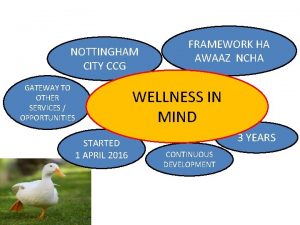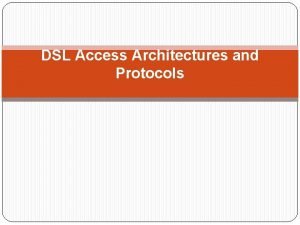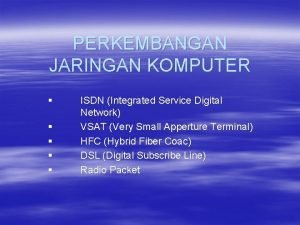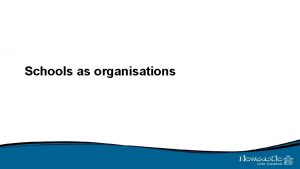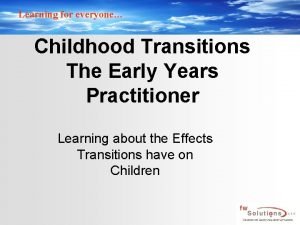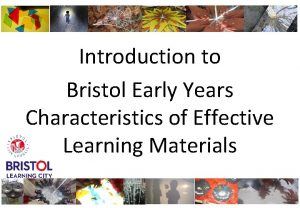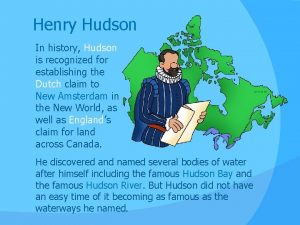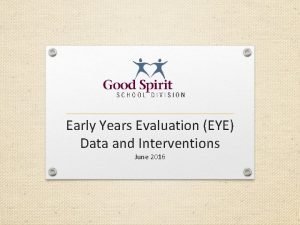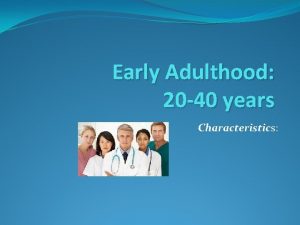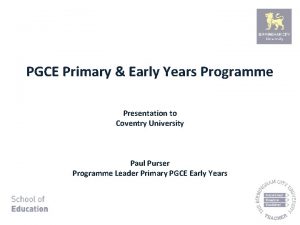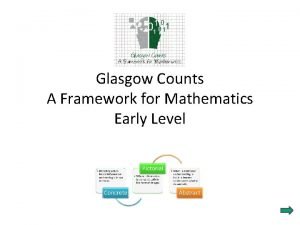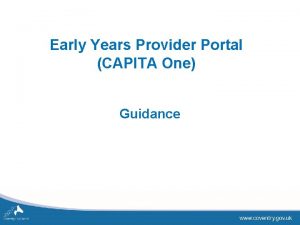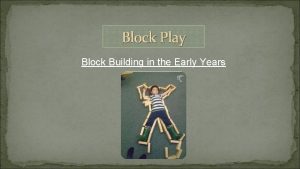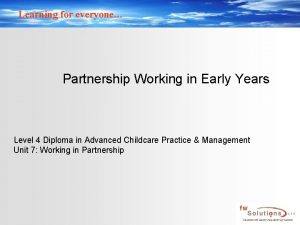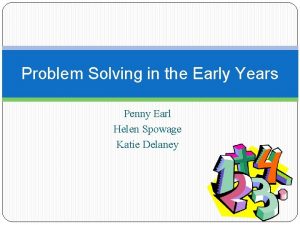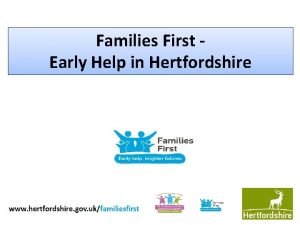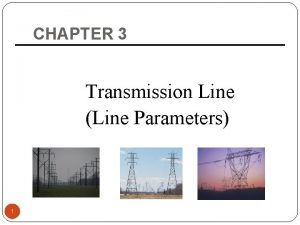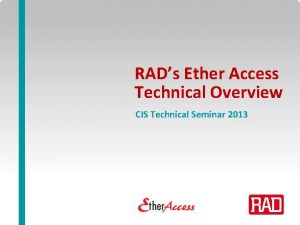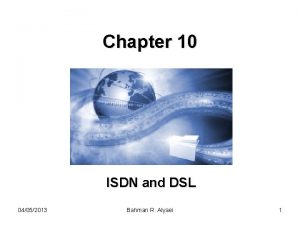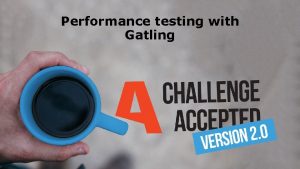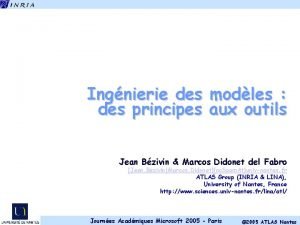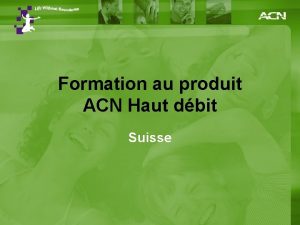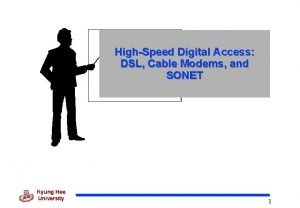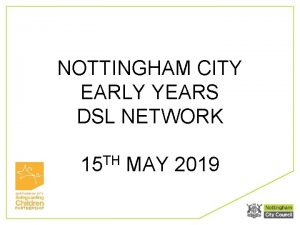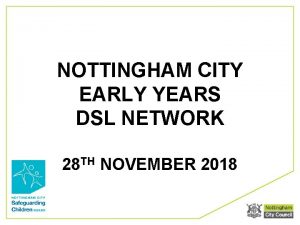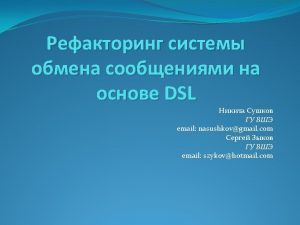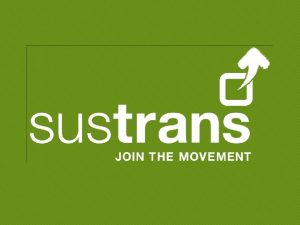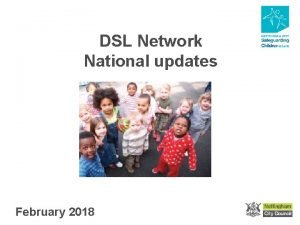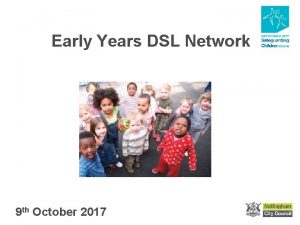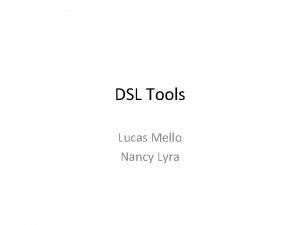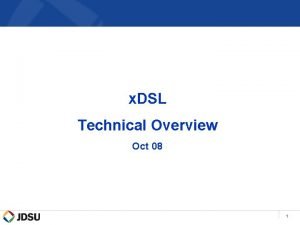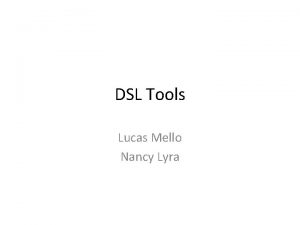NOTTINGHAM CITY EARLY YEARS DSL NETWORK 13 TH





























































- Slides: 61

NOTTINGHAM CITY EARLY YEARS DSL NETWORK 13 TH FEBRUARY 2020



Revisit of network purpose and role and responsibilities of DSL’s • To promote connectivity with the Nottingham City Safeguarding Children Partnership • Act as a conduit for policy updates • A practice network which demonstrates professional behaviours and mutual support

Role and Responsibilities of DSL’s • Commitment to own development • Responsible for own learning from the network • Cascade information to staff team • Other safeguarding forums - information

Early Years Updates • Feedback from previous network • Record Keeping and Report Writing briefing • Training

Recording and Report Writing Briefing Tuesday 25 th February 2020 9. 30 am – 11 am OR 11. 30 am – 1 pm At Nottingham Nursery School and Training Centre Book – eytraining@nottinghamcity. gov. uk

Training Opportunities • Every Colleague Matters - Laura Sanders 8765078 • Principles of Safer Recruitment – cancelled • Signs of Safety Workshops; Tuesday 28 th April 2020 - 1. 30 pm – 4. 30 pm • Monday 13 th July 2020 - 9. 30 am – 12. 30 pm • Monday 14 th September 2020 - 9. 30 am – 12. 30 pm • Thursday 12 th November 2020 - 9. 30 am – 12. 30 pm

Follow Nottingham City Safeguarding Children's Partnership https: //www. nottinghamcity. gov. uk/ncscp https: //twitter. com/Nottingham. CSCP

Improving Practice Learning from Reviews Mandy Smith Children’s Officer NCSCP

Session Plan • A reminder of the statutory review process as set out in Working Together 2018 • Summary of local review findings 2019/20 • Explore some of the key practice issues highlighted in local reviews • Update on national reviews • To provide participants with an opportunity to reflect on their practice

Safeguarding Arrangements • From Safeguarding Boards to Partnerships • Statutory Partners • Local Authority • Police • Clinical Commissioning Group • Key responsibility remain - multi agency safeguarding arrangements • Introduction of RR • Change in terminology (SCR – CSPR)

Serious Incident Notification Duty on local authorities to notify incidents to the Child Safeguarding Practice Review Panel 16 C(1) of the Children Act 2004 (as amended by the Children and Social Work Act 2017) states: • Where a local authority in England knows or suspects that a child has been abused or neglected, the local authority must notify the Child Safeguarding Practice Review Panel if: (a) the child dies or is seriously harmed in the local authority’s area, or (b) while normally resident in the local authority’s area, the child dies or is seriously harmed outside England Ref: WT 2018 Page 84

Rapid Review Requirements The safeguarding partners should promptly undertake a rapid review of the case, in line with any guidance published by the Panel. The aim of this rapid review is to enable safeguarding partners to: • gather the facts about the case, as far as they can be readily established at the time • discuss whethere is any immediate action needed to ensure children’s safety and share any learning appropriately • consider the potential for identifying improvements to safeguard and promote the welfare of children • decide what steps they should take next, including whether or not to undertake a local child safeguarding practice review (or recommend National Review)

Child Safeguarding Practice Reviews (CSPR) Two types of CSPR • Local • National

Criteria The criteria which the local safeguarding partners must take into account include whether the case: • highlights or may highlight improvements needed to safeguard and promote the welfare of children, including where those improvements have been previously identified • highlights or may highlight recurrent themes in the safeguarding and promotion of the welfare of children • highlights or may highlight concerns regarding two or more organisations or agencies working together effectively to safeguard and promote the welfare of children • is one which the Child Safeguarding Practice Review Panel have considered and concluded a local review may be more appropriate

Principles • Reviews should support a shared culture of continuous learning and improvement • Identify opportunities to draw on what works and promotes good practice. • Be proportionate according to the scale and level of complexity • Involve professionals fully to contribute their perspective without fear of blame

Principles continued • Recognises the complex circumstances in which professionals work together to safeguard children • Seek to understand precisely what happened and the underlying reasons that led individuals and organisations to act as they did. • Seeks to understand practice from the viewpoint of individuals involved • Be independent

Value added by practitioners • Hear first hand accounts from those involved with the family • Understand the working practices and environment at the time • Make sense of behaviour / actions & decision making • Allow for personal reflection • Confirm and challenge • Supports learning and improvement

Local Reviews • Two Serious Case Reviews – completed in 2019 • Three Rapid Reviews – 2019 -20

Case Summaries Serious Case Review • Physical Abuse / primary school aged child (Case B) Sustained life threatening head injury / history of service involvement Recent and historic. Rapid Review • 3 week old baby / Sudden unexpected death (case E) Open case to Childrens social work team / elements of unsafe sleeping

Case B - Child R Characteristics - case elements Physical injury / repeated concerns about injuries sustained / disguised compliance by mother / hidden male / reliance on disclosure The key findings from the review • Section 47 child protection procedures were not followed • There weaknesses in the children’s assessment and evidence of confirmatory bias. Influenced by mothers self-reporting and the child’s positive presentation. • Consideration of child R’s lived experiences was inadequate, specifically his experience of thirteen injuries over a period of nine months. • There was an absence of chronologies in case files and to support safeguarding referrals. Both of which could have supported identification of injury patterns earlier.

Case B – Child R Learning Effective Compliance with Interagency Safeguarding Procedure Quality Assessments use of Chronologies

Case E Characteristics - case elements – 3½ week old infant SUDI elements of unsafe sleeping. Substance misuse / Domestic Violence / open Children in Need case at the time of death. Findings • Gaps in the pre-birth assessment • Breakdown in communication / information sharing in relation to Domestic Violence incident • Unsafe sleeping practice • Engagement with the GP Learning • Post birth – risk of relapse (substance / alcohol)

Cross Cutting Themes • Adherence to procedure • Section 47 • Referrals • Private Fostering arrangements • Quality of assessments • Effective use of Chronologies • Unsafe sleeping • Gaps in information sharing • Engagement with GP’s • Escalation

Activity Table discussion Reflect on case summaries and share with colleagues: • • Initial thoughts Surprises Concerns Key learning point

National Child Safeguarding Practice Reviews Current National Reviews Adolescents in need of state protection from criminal exploitation SUDI where children are considered at risk of harm Reviews at planning stage Physical abuse/NAI in children 0 – 1 year with a focus on men as perpetrators – currently in planning stages Other potential areas for review Elective Home Education Parent care leavers

Useful link Local Serious Case Reviews • https: //www. nottinghamcity. gov. uk/information-for-residents/childrenand-families/nottingham-city-safeguarding-children-board/learningfrom-practice/serious-case-reviews/

Safer Sleeping • SIDS claims the lives of around 5 babies a week in the UK. • Following safe sleep advice reduces the likelihood of SID’s occurring • April 2009 – March 2019 71 infants sudden, unexplained deaths. • In 49 unsafe sleeping practice was present • 5 deaths locally could possibly have been avoided

Safer Sleeping • • safer sleep for babies video safer sleeping self directed learning session safer sleeping risk assessment tool Nottingham City Safeguarding Children Partnership and Nottinghamshire Safeguarding Children Partnership have developed the Safer Sleeping Risk Assessment Tool to support practitioners to identify if parents or carers are putting a baby to sleep in an unsafe way. A self-directed learning session has also been developed to help practitioners learn about: What guidance to give carers to ensure they are putting babies to sleep safely Sudden Infant Death Syndrome (SIDS) the risk factors for SIDS

Useful links • Lullaby Trust – safer sleeping https: //www. lullabytrust. org. uk/? gclid=EAIa. IQob. Ch. MIo. JWG 3 Mq. F 5 w. IVwr. Tt. Ch 3 Zh. ASWEAAYASAAEg. Lqzf. D_Bw. E • Safer sleeping – self directed learning session https: //www. nottinghamcity. gov. uk/information-forresidents/children-and-families/nottingham-city-safeguardingchildren-board/safeguarding-training/free-e-learning/

National Updates John Matravers

Safer Internet Day Videos Safer Internet Day was Tuesday 11 th February 2020. The UK Safer Internet Centre have released a series of films to be used as discussion starters. The films are: • • #freetobe What does my avatar say about me? Are you #freetobe yourself online How can parents talk to children about their online lives? The videos are also available with British Sign Language (BSL) interpretation. The films can be here: https: //www. saferinternet. org. uk/sid-films A really useful can be found below. https: //www. nspcc. org. uk/keeping-children-safe/online-safety/

Freedom of Information request to Police ● A Freedom of Information request to police forces in England Wales shows there were at least 4, 373 offences of sexual communication with a child recorded in the year to April 2019 compared with 3, 217 in the previous year. The data revealed: ● Where age was provided, 1 in 5 victims were aged just 11 or younger ● The number of recorded instances of the use of Instagram was more than double that of the previous year. ● In the last 2 years, Facebook-owned apps (Facebook, Messenger, Instagram and Whats. App) and Snapchat were used in more than 70% of the instances where police recorded and provided the communication method

Data Finding information about your local context It is important that schools understand their local context, but it is not also easy to find the information. Listed below are a number data sources that might help with this search. Child and Maternal Health Data Area profiles Vulnerable children and young people https: //fingertips. phe. org. uk/profile/child-healthprofiles/data#page/1/gid/1938133238/pat/6/par/E 12000004/ati/102/are/E 10000021/iid/90803/ag e/173/sex/4 Children in care (2018) https: //fingertips. phe. org. uk/profile/child-healthprofiles/data#page/3/gid/1938133238/pat/6/par/E 12000004/ati/102/are/E 06000015/iid/90803/ag e/173/sex/4

Deprivation Local Authority maps Index of Multiple Deprivation https: //imd 2019. group. shef. ac. uk/ Indices of Deprivation Maps http: //dclgapps. communities. gov. uk/imd/iod_index. html Crime Search the crime map for your area https: //www. police. uk/search/ Download police data https: //data. police. uk/ National Crime Agency Threat Reports https: //www. nationalcrimeagency. gov. uk/who-we-are/publications/173 -nationalstrategic-assessment-of-serious-and-organised-crime-2018/file Child Protection Data NSPCC Child Protection Data How safe are our children? 2013 - 2019 https: //learning. nspcc. org. uk/research-resources/how-safe-are-our-children/

Local Updates John Matravers

Neglect ● “We must be ambitious for all our children” ● Is deprivation now seen as the “new norm”? There are implications for recognition of neglect and what ● ● ● constitutes ‘good enough care’. Neglect is the ongoing failure to meet a child's basic needs and the most common form of child abuse. A child might be left hungry or dirty, or without proper clothing, shelter, supervision or health care. This can put children and young people in danger. And it can also have long term effects on their physical and mental wellbeing. Physical neglect a child's basic needs, such as food, clothing or shelter, are not met or they aren’t properly supervised or kept safe. Educational neglect a parent doesn't ensure their child is given an education or learning opportunites Emotional neglect a child doesn't get the nurture and stimulation they need. This could be through ignoring, humiliating, intimidating or isolating them. Medical neglect a child isn't given proper health care. This includes dental care and refusing or ignoring medical recommendations. https: //www. nspcc. org. uk/what-is-child-abuse/types-of-abuse/neglect/

New Prevent Referral Form • 0115 9670999 Ext: 8002963 • Prevent@Nottinghamshire. pnn. police. uk


Priority Family workshop for parents

Ofsted

Cyber Choices Introduction and Referral Process

UNDERSTANDING CYBERCRIME & CHILDREN • ‘More teens of this age have hacked a computer than • • have had sex or are regular smoker’ University College London (2019) The most common age of children in the East Midlands getting into Computers is under 8 years old The most common time category that children spend on computers in East Midlands is ‘Over 40 hours’ 100% of all referrals within the East Midlands are Male The youngest referral so far… 7 years old!


Prevent Objectives

What is Cybercrime? Not Pure Cybercrime For example: Cyberbullying, Online Fraud, Online Grooming, Malicious Communications Pure Cybercrime For example: Hacking, Ransomware, DDo. Sing

The Rise in Cybercrime • £ 190, 000 a day is lost in the UK by victims of cybercrime • Cybercrime now accounts for more than 50% of all crimes in the UK • Malicious hackers are now attacking computers and networks at a rate of one attack every 39 seconds • Two-thirds of hackers began hacking before they turned 16

Computer Misuse Act • Accessing data/files etc. without permission E. g. Breaking into Computer Networks • Accessing data/files etc. without permission & intending to do something bad • Actually doing something bad to disrupt/impair computer functionality E. g. DDOS attack • Doing something so bad you cause a lot of material damage E. g. NHS

Spotting the Signs How many of these do you know?

Other things to look out for… Key logger USB loaded with Scripts

Case Study Examples Case B Case A 1 2 3 1 4

Cyber Choices • Where is it? www. cyber 4 schools. net • What do we do when we receive a referral? • What support/diversions can we offer?

Improving Your Online Activity

Improve your Password! 1 2 3 4 5 6 7 8 9 10 11 123456 password 1234567 qwerty 12345 Letmein football admin nija sunshine Welcome

Use a Strong Password! 1. 2. 3. 4. ‘Password’ ‘Lucy 1992’ ‘Mar. Mite 83’ ‘Sand. Music. Warm!’ INSTANTLY 2 HOURS 4 DAYS 29 MILLION YEARS

Things that you can do! • Disconnect Browser Add On • Don’t ignore update prompts Shutdown periodically 'Windows Update' in the search bar Use The ‘App Store’ Icon Use The Manufacturer’s Software Check Your Browser whatismybrowser. com • Buy a purpose built Anti-Virus • • • blocks tracking HTTPS – encrypts activity Delete Cookies Different Browsers Facebook & Shopping Log Out when done. Email- Unsubscribe

Phishing Emails • 66% of malware is installed via malicious email attachments • 64% of organizations have experienced a phishing attack in the past year • 50% of recipients open e-mails and click on phishing links within the first hour of being sent • 3. 4 bn fake emails are sent out worldwide each day

Any Questions? EMSOU_Prevent@Leicestershire. pnn. police. uk

Next DSL Network Wednesday 20 th May 2020 At Basford Hall Conference Centre 9 am – Networking 9. 30 am – 12. 30 pm presentations

 Nottingham city early years
Nottingham city early years Dsl 1 dsl 2
Dsl 1 dsl 2 Nottingham city council works perks
Nottingham city council works perks Awaaz nottingham
Awaaz nottingham Nottingham city hospital respiratory assessment unit
Nottingham city hospital respiratory assessment unit Apartude
Apartude Dsl architecture
Dsl architecture Isdn komputer adalah
Isdn komputer adalah Sheep years to human years
Sheep years to human years 300 solar years to lunar years
300 solar years to lunar years Where is this image
Where is this image Early years of william shakespeare
Early years of william shakespeare Jean baptiste louis gros
Jean baptiste louis gros Summarise types of early years provision
Summarise types of early years provision Big builders medway
Big builders medway Effects of transitions in early years
Effects of transitions in early years Bristol early years characteristics of effective learning
Bristol early years characteristics of effective learning Henry hudson netherlands
Henry hudson netherlands Hampshire early years advisory team
Hampshire early years advisory team Early years learning framework overview
Early years learning framework overview Eye early years evaluation
Eye early years evaluation Characteristics of early adulthood stage
Characteristics of early adulthood stage Pgce early years
Pgce early years Glasgow counts early years
Glasgow counts early years Coventry early years portal
Coventry early years portal Block play early years
Block play early years Pablo picasso early work
Pablo picasso early work Mark making reception
Mark making reception Early learning for everyone
Early learning for everyone Eyitt course
Eyitt course Penny earl and mark
Penny earl and mark Families first hertfordshire contact number
Families first hertfordshire contact number Early years summit
Early years summit Early years foundation stage pack
Early years foundation stage pack Early cpr and early defibrillation can: *
Early cpr and early defibrillation can: * Primo dsl
Primo dsl Rad etx 203 ax
Rad etx 203 ax Gmr of 4 strand conductor
Gmr of 4 strand conductor Ad-dsl
Ad-dsl Andrew hall safeguarding
Andrew hall safeguarding Web untis dsl
Web untis dsl Ether access
Ether access Dsl adalah
Dsl adalah Modernisierungskredit bonn
Modernisierungskredit bonn Isdn stands for
Isdn stands for Transparent lan service
Transparent lan service Gatling randomswitch
Gatling randomswitch Ingnierie
Ingnierie Acn cable
Acn cable Digital subscriber line ppt
Digital subscriber line ppt Acn internet
Acn internet Acn dsl
Acn dsl Visual studio dsl
Visual studio dsl Asymmetrical dsl
Asymmetrical dsl Dsl
Dsl Dsl osi layer
Dsl osi layer What does spoa stand for
What does spoa stand for Dsl x
Dsl x Uni dsl
Uni dsl Lattes platform
Lattes platform Highspeed dsl
Highspeed dsl Dslon
Dslon



